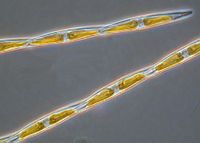
Photo from wikipedia
The domoic acid (DA) produced by certain species of the marine pennate diatom genus Pseudo-nitzschia is highly neurotoxic and can induce nerve excitability and neurotoxicity by binding with ionotropic glutamate… Click to show full abstract
The domoic acid (DA) produced by certain species of the marine pennate diatom genus Pseudo-nitzschia is highly neurotoxic and can induce nerve excitability and neurotoxicity by binding with ionotropic glutamate receptors, causing amnesic shellfish poisoning in humans who consume seafood contaminated with DA. In recent years, poisoning to humans caused by DA has occurred around the world, which has attracted increasing attention, and studies on DA production by Pseudo-nitzschia have become the hotpot. This article reviews the progress on the biosynthesis of DA by the typical diatom Pseudo-nitzschia, in which the metabolic pathway of the biosynthesis of DA and its precursors, i.e., geranyl pyrophosphate and L-glutamate, and the various environmental factors affecting DA production including temperature, light intensity, nutrients, trace metals, and alien bacteria are discussed. The detection methods of DA (including bioassays, enzyme linked immunosorbent assays, high performance liquid chromatography, capillary electrophoresis and biosensors), as well as the morphology and toxigenicity of Pseudo-nitzschia are also presented.
Journal Title: Current pharmaceutical biotechnology
Year Published: 2022
Link to full text (if available)
Share on Social Media: Sign Up to like & get
recommendations!